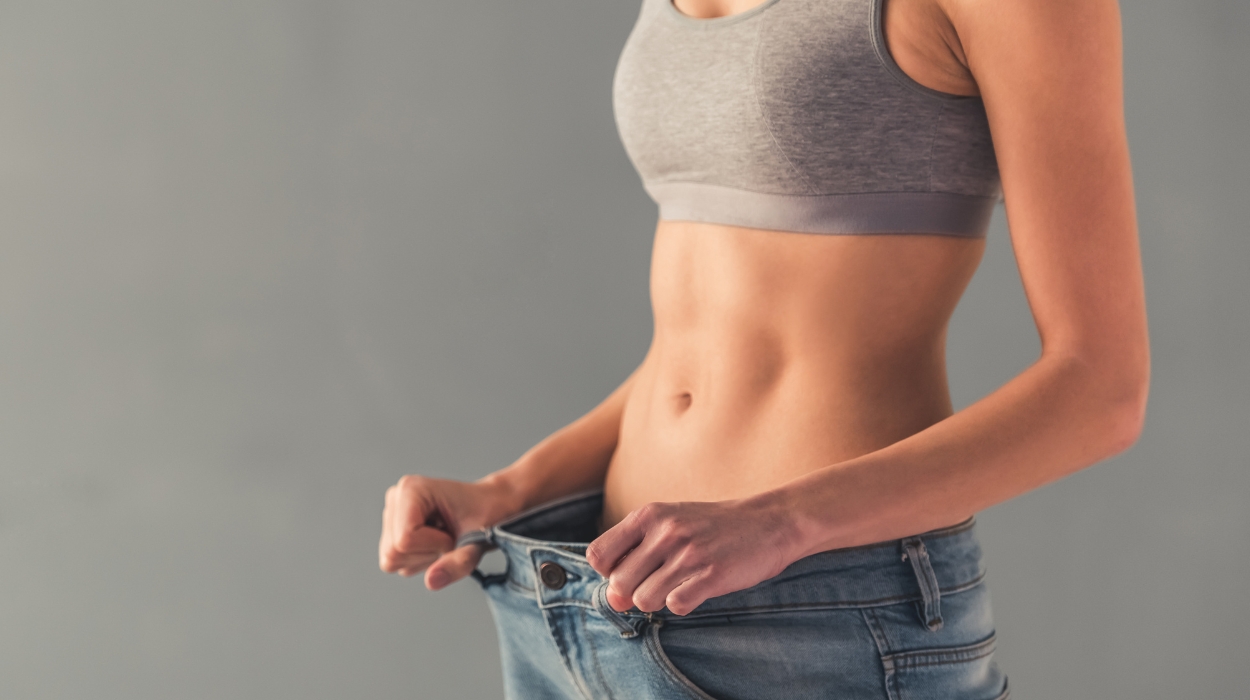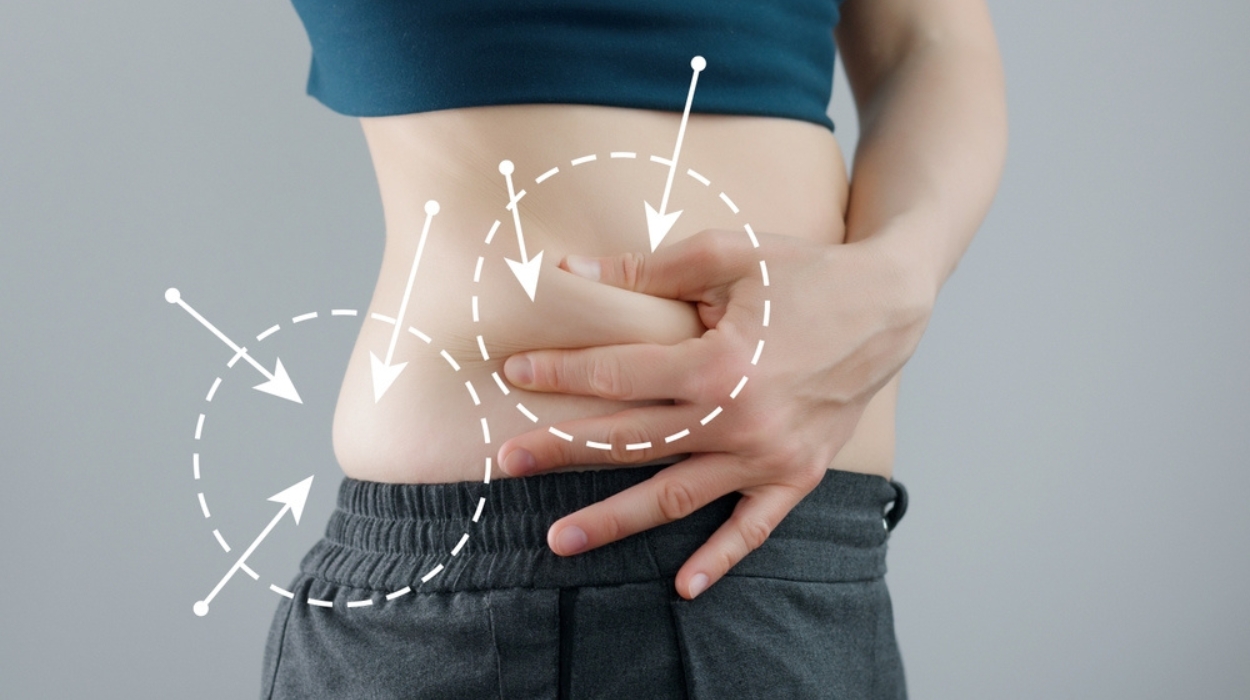Not everyone loves exercise. Sure, we know it is good for us, but finding the time and motivation can be hard. But when we have stubborn pockets of body fat that we want to eliminate, can diet alone show us how to lose hip fat fast?
Good news for those wondering how to lose hip fat without exercise: your diet can do it. However, it may not be the fastest or most sustainable method. Read on to find out more!
Tips To Reduce Hip Fat Without Exercise
Some proven ways to lose hip fat without exercise include:
- Cutting back on sugary beverages and increasing water.
- Consuming fiber-rich foods and probiotics.
- Sleeping well and managing stress.
- Eating high-protein meals cooked at home.
- Eating slowly and without any distractions.
Proven Ways To Lose Hip Fat Without Exercise

For any kind of weight loss, the best results are obtained with a combination of diet and exercise.[1] This is because exercise will help you burn more calories throughout your day, meaning you have a higher chance of being in a calorie deficit to lose fat.
Losing weight using a diet only depends on three main things:[2] how much you eat, what types of food you eat, and when you eat your meals.
The most crucial part of losing weight, and therefore hip fat, is eating fewer calories than your body burns. This is called an energy deficit. In some cases, people might need to follow a very low-calorie diet for a short time. Other diets or fat-burning supplements might work for some people, but we don’t know the long-term effects.
What is important to realize is that there’s no one-size-fits-all way to lose weight. Everyone is different, so the best approach should be tailored to each person’s preferences and needs.
Cut Back On Sugary Beverages And Increase Water
Consuming excessive calories from these drinks is easy, as liquid calories don’t induce satiety like solid, healthy foods. Sugar-sweetened beverages are popular worldwide, with consumption levels exceeding the recommended daily sugar intake[3] in many nations. Even in developing countries, the intake of these beverages is increasing. Studies strongly suggest that these beverages contribute to weight gain.
The rapid absorption of glucose from these drinks can also cause a spike in your blood sugar and excessive insulin levels in the blood. There’s also a possibility that these drinks trigger the brain’s reward system, further encouraging their consumption.
People who have successfully lost weight and kept it off tend to drink low or no-calorie sweetened beverages.[4] Most people felt that these drinks helped them control their total calorie intake and avoid weight gain. The most common strategy was drinking more water and reducing regular calorie drinks. Drinking water, especially before meals, can reduce your appetite and food intake.[5]
Consume Fiber-Rich Foods And Probiotics
Eating more fiber-rich foods and less processed foods can help people lose weight[6] Studies show that those who lose weight tend to eat significantly more fiber-rich foods like fruits, vegetables, and beans than those who struggle to lose weight. Participants who ate more servings of grains also considerably increased their weight loss.
Interestingly, recent research has shown a connection between obesity and the bacteria living in our intestines,[7] known as the gut microbiota. Studies on animals have suggested that these bacteria may play a role in obesity. In obese individuals, the composition of the gut microbiota changes, affecting how much energy we get from food, how our body stores fat, and how we metabolize carbohydrates and fats in the liver.
This study found that a diet high in fats, preservatives, and carbs but low in fiber can negatively affect the bacteria living in our gut. When this happens, it can lead to inflammation and health problems like obesity and diabetes. The study suggests that taking probiotics can help you shed excess fat, which can include hip fat.
Combining different probiotic strains appears more effective than using one type. Their effect is also more potent when combined with prebiotics, substances, a healthy diet, and physical activity.
Sleep Well And Stress Less

Insufficient sleep can interfere with the hormones that regulate appetite, leptin and ghrelin. Moreover, stress can elevate cortisol levels, another hormone that plays a role in weight management.
According to recent research, people who regularly slept less than seven hours a night were likelier to have higher body mass indexes[8] than those who slept more. Inadequate sleep was linked to increased salt retention, inflammation markers, and ghrelin levels or the hunger hormone. Furthermore, poor sleep was linked to decreased insulin sensitivity and lower leptin levels, the hormone that makes you feel full. The fluctuation of these hormones can heighten hunger and cravings, increasing calorie intake.
Other studies point out links between stress and obesity,[9] specifically belly fat. The hormone cortisol, which our bodies produce during stress, might be a key player in this relationship. People with higher long-term cortisol levels were likelier to have excess fat, especially in the abdominal area.
Cook High-Protein Meals At Home
Eating more protein can help you lose weight and improve your body composition[10] by reducing excess fat, like hip fat while maintaining muscle mass. This effect was seen in diets with both low and standard calories.
A high-protein diet can also affect hormones in our gut that control our appetite. It increases levels of hormones that make us feel full and decreases hormones that make us feel hungry. This results in us feeling satisfied for longer and likely to eat fewer calories.
Eating more protein also generates increased heat production in the body, higher levels of amino acids in the blood, and heightened glucose production in the liver. It also supports ketogenesis, the process of breaking down fats for energy. All these factors contribute to a feeling of fullness.
High-protein diets increase energy expenditure through two mechanisms. Digesting proteins requires more energy than carbs and fats, and consuming protein helps maintain muscle mass. Lean muscle mass helps maintain our resting energy expenditure even when we lose body weight.
Preparing your meals allows you to control the ingredients and portion sizes. Research suggests that home-cooked meals are associated with a better diet and a lower risk of obesity.[11] People who cook and eat meals at home tend to eat more fruits and vegetables and have an average body mass index and body fat percentage. In fact, people who ate home-cooked meals more than five times a week were 28% less likely to be overweight and 24% less likely to have excess percentage body fat.
Slow Down And Avoid Distractions
While few studies are available, some have shown that people who ate quickly found the meal more enjoyable and satisfying. However, those who ate slowly reported feeling fuller two hours after the meal[12] and had higher levels of the satiety hormone and lower levels of the hunger hormone. These findings suggest that taking your time to eat could be a good way to help with weight loss.
Being distracted while eating might be linked to weight.[13] Studies have shown that people who watch TV or work while eating tend to have a higher BMI. This particular study suggests that besides age and education level, being distracted during lunch and snack time was one of the biggest predictors of BMI.
Cosmetic Interventions
Various cosmetic interventions[14] exist for those who want to spot target hip fat without exercise. For example, liposuction removes fat from the body using a vacuum-like device. Cryoliposis can also help remove stubborn fat[15] in localized areas with minimal discomfort. Furthermore, non-invasive procedures like radiofrequency therapy can reduce cellulite and tone muscle tissue.[16]
Does It Take Longer To Lose Hip Fat Without Exercise?
The most crucial factor for weight loss is creating an energy deficit. Exercise can help to create an energy deficit by burning calories. Resistance exercise and strength training can also help build muscle, increasing your resting metabolic rate, which is the amount of calories you burn at rest. Without exercise, it may take longer to lose hip fat because your body will not receive the same stimulus from physical activity.
Conclusion
It is possible to lose hip fat without exercise, using a diet to maintain a caloric deficit or through cosmetic interventions. However, this is not the healthiest or most sustainable way to lose weight in any area of the body. Exercise is integral to a healthy lifestyle and may even accelerate your weight loss outcomes. If you have questions about weight loss, consider meeting with a registered dietitian nutritionist.
Frequently Asked Questions
Yes, it is possible to lose fat without exercise by entering into a caloric deficit with diet only.
There are many causes of hip fat, including genetics, dietary, and lifestyle factors.
Depending on the methods used, it can take weeks to months to start seeing a reduction in hip fat. Everyone’s weight loss journey is unique.
A well-balanced diet consisting of lean protein, fiber, probiotics, and vegetables can help you lose weight.
Any exercise that increases energy expenditure can help reduce hip fat.
osing thigh fat without exercise can be done with calorie-deficit diets or cosmetic interventions.
 Evidence Based
Evidence Based